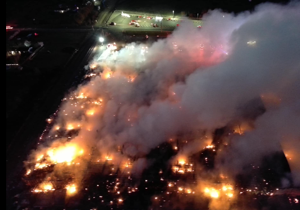
RICHLAND. Wash –
Aircraft emissions account for 10% of all U.S. transportation green house gas emissions according to the EPA. One lab in the Tri-cities is working to help reduce emissions from planes starting at the source.
The Bioproducts Sciences and Engineering Laboratory on the WSU Tri-Cities campus is testing new types of fuels for future use in jets.
Making the fuel takes building up and breaking down resources that would otherwise go to waste according to the Director of the lab Joshua Heyne.
“You know I joke that if you, everything you flush down your toilet, throw away in the trash, or breathe out of your body could be turned into sustainable aviation fuel,” Heyne said.
Sustainable Aviation Fuel or SAF is meant to be drop-in ready, meaning planes won’t have to change anything to use it. Heyne said the plan is to help countries meet climate goals sooner without the need to develop entirely new planes.
“SAF is the biggest lever to decarbonize aviation by 2050,” he said.
Graduate students at the lab test samples they receive on several different requirements.
David Bell, a graduate student who focuses on the chemistry, said he usually knows when a sample isn’t going to work early on.
“I feel like I get yelled at because I’m the one who sometimes has to give the bad news,” Bell said.
When the composition is wrong, it can mean fuel freezing at certain temperatures and altitudes, it can do damage to pieces in the plane, or it can be unsafe to handle in the large quantities put in planes.
“Every one of these properties by themselves is not catastrophic if it failed like it probably could work, but when you get on a plane, you don’t want to probably land,” he said.
Harrison Yang, another grad student in the lab, said he’s seen companies come a long way in developing SAF with many using a base of excess cooking oil, or beef tallow to build up a compound.
“We know roughly what percentage we want stuff to be – to have the highest performance and also meeting the safety aspect and trying to reduce sooting, but the question is can the fuel producer make them?”
Companies send samples to the lab in Richland to test milliliters of what they are developing. The hope is to reduce costs before trying to enter the official qualification process according to Heyne.
“Producers say that to just enter the qualification process, with only a hundred gallons of material it was roughly a hundred million dollars of investment,” he said.
Heyne said the biggest challenge for companies once they’ve found the right balance is scale and cost.
He said while some companies have made a working SAF, overall production is decades away from having the volume needed to fully replace current fuels.
“Within the next couple of years there’s about 400 million gallons of SAF production that’s projected,” Heyne said. “Going into I think 2028 around 1.1 billion gallons of US domestic production is anticipated.”



